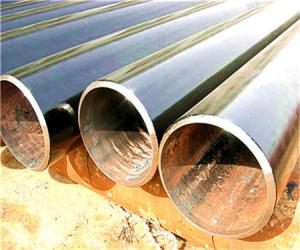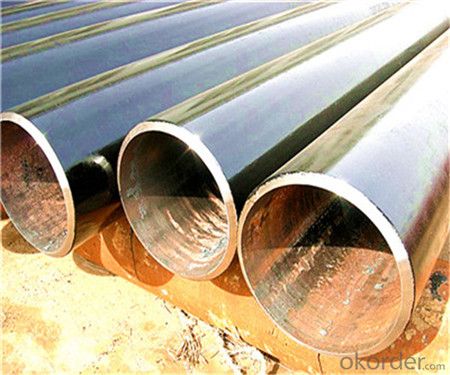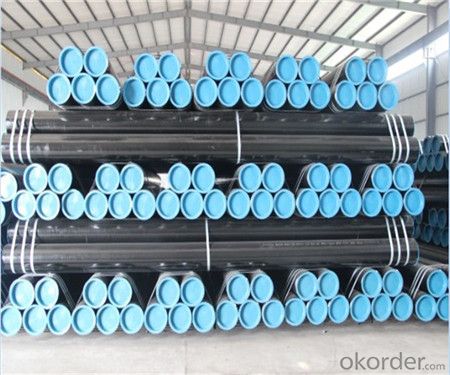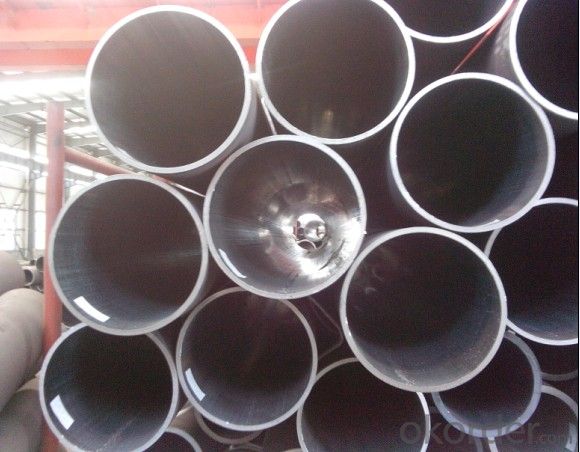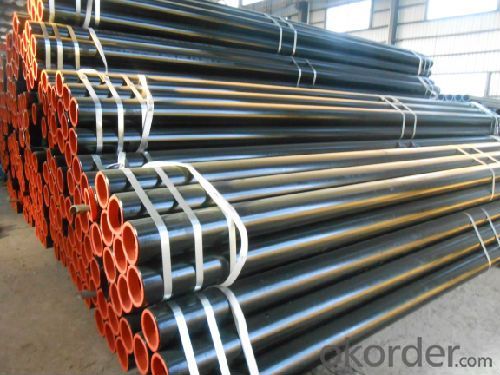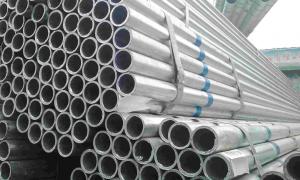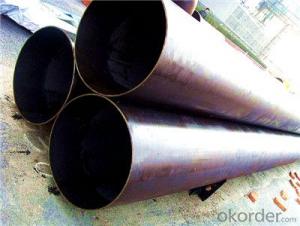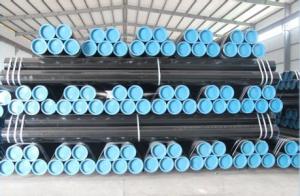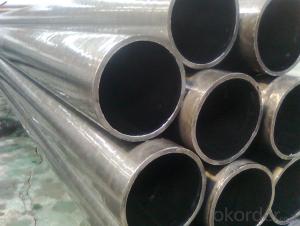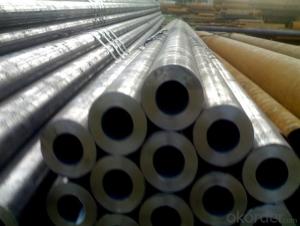Seamless Pipe for Pressure Purpose(DIN1629) Manufacturer
- Loading Port:
- China Main Port
- Payment Terms:
- TT or LC
- Min Order Qty:
- 30 m.t.
- Supply Capability:
- 12000 m.t./month
OKorder Service Pledge
OKorder Financial Service
You Might Also Like
1、Full series of products provides an easier access for one stop purchase
▲ Line pipe
▲ Tubing and casing
▲ L & M & H boiler tube
▲ Gas cylinder tube & pipe
▲ Mechanical & Structural pipe
▲ Ship-building tube & pipe
▲ Automobile tube & pipe
2、Main Features of the Seamless Pipe ASTM A106/53:
• High manufacturing accuracy
• High strength
• Small inertia resistance
• Strong heat dissipation ability
• Good visual effect
• Reasonable price
3、Seamless Pipe ASTM A106/53 Specification:
Standard | GB, DIN, ASTM ASTM A106-2006, ASTM A53-2007 |
Grade | 10#-45#, 16Mn 10#, 20#, 45#, 16Mn |
Thickness | 8 - 33 mm |
Section Shape | Round |
Outer Diameter | 133 - 219 mm |
Place of Origin | Shandong, China (Mainland) |
Secondary Or Not | Non-secondary |
Application | Hydraulic Pipe |
Technique | Cold Drawn |
Certification | API |
Surface Treatment | factory state or painted black |
Special Pipe | API Pipe |
Alloy Or Not | Non-alloy |
Length | 5-12M |
Outer Diameter | 21.3-610mm |
Grade | 20#, 45#, Q345, API J55, API K55, API L80, API N80, API P110, A53B |
Standard | ASME, ASTM |
4、Packaging & Delivery
Packaging Details: | seaworthy package,bundles wrapped with strong steel strip |
Delivery Detail: | 15-30days after received 30%TT |
5、FAQ of Seamless Pipe ASTM A106/53:
Why should you chose us?
● Full series of products provides an easier access for one stop purchase
▲ Electric Resistance Welded (ERW) Steel Pipe
▲ Longitudinal Submerged Arc Welded (LSAW) Steel Pipe
▲ Spiral Submerged Arc Welded (SSAW) Steel Pipe
▲ Hollow Section (Square and Rectangle Pipe)
▲ Hot Dipped Galvanized Steel Pipe
6、Seamless Pipe ASTM A106/53 Images:
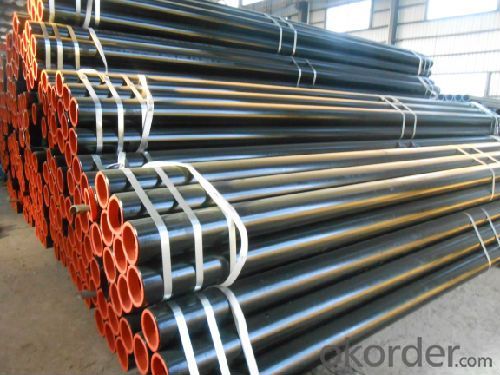

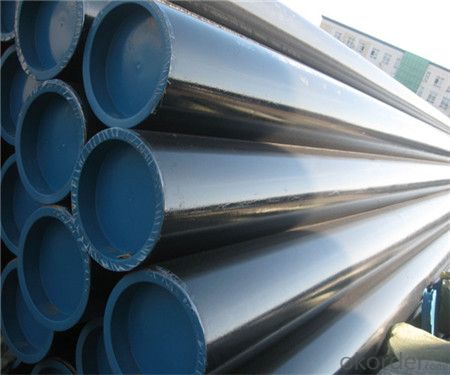
- Q: What is the difference between black steel pipes and galvanized steel pipes?
- Black steel pipes are made of carbon steel and are typically used in gas or oil lines, while galvanized steel pipes are coated with a layer of zinc to protect against corrosion. Galvanized pipes are commonly used in plumbing systems and outdoor applications.
- Q: What are the lengths of scaffold steel tubes?
- Used to build scaffolding of steel pipes in general have two kinds, an outer diameter 48mm, wall thickness 3.5mm; another kind of outer diameter 51mm, wall thickness 3mm; according to its location and role of different, can be divided into vertical pole, horizontal rod, sweeping rod, etc.. According to the technical specification for construction of steel tubular scaffold with couplers, JGJ 130 - 2011[1]. The scaffolding steel pipe should be specified with the current national standard "GB/T13793" or "straight seam welded steel pipe welded steel pipe for low pressure liquid delivery" GB/T3091 Q235 ordinary steel pipe; steel pipe steel quality should meet the requirements of current national standard grade Q235 steel "carbon structural steel" in GB/T700. The scaffold pipe shall be made of a diameter of 48.3 * 3.6 steel tubes. The maximum mass of each steel tube shall not be greater than 25.8kg.
- Q: How are steel pipes tested for quality control?
- Steel pipes are tested for quality control through various methods such as visual inspection, non-destructive testing, and physical testing. Visual inspection involves checking the pipes for any visible defects or inconsistencies in their appearance. Non-destructive testing methods like ultrasonic testing, magnetic particle testing, and radiographic testing are used to detect internal flaws or defects without damaging the pipes. Additionally, physical tests like tensile and impact testing are performed to evaluate the mechanical properties of the pipes. These comprehensive testing techniques ensure that steel pipes meet the required quality standards before they are used in various applications.
- Q: Are steel pipes fire resistant?
- Yes, steel pipes are considered fire resistant due to their high melting point and ability to withstand extreme heat.
- Q: How are steel pipes used in the manufacturing of machinery and equipment?
- Steel pipes are commonly used in the manufacturing of machinery and equipment due to their strength, durability, and versatility. They serve various purposes such as the transportation of fluids, gases, and materials within the machinery, acting as structural components, providing support for moving parts, and facilitating heat transfer or cooling. Steel pipes also allow for easy assembly and disassembly, making them essential in the manufacturing process of machinery and equipment.
- Q: What are the different methods of joining steel pipes together?
- There are several methods of joining steel pipes together, each with its own advantages and disadvantages. 1. Welding: This is the most common and widely used method of joining steel pipes. It involves heating the ends of the pipes and applying pressure to fuse them together. Welding provides a strong and durable joint, but it requires skilled labor and specialized equipment. 2. Threaded connections: Steel pipes can also be joined by threading the ends and using threaded fittings to connect them. This method is relatively easy and quick, but it may not be as strong as welding and can be prone to leakage if not properly sealed. 3. Flanged connections: Flanges are used to connect pipes by bolting them together. This method allows for easy disassembly and reassembly, making it suitable for applications that require frequent maintenance or repair. Flanged connections are also highly resistant to leakage. 4. Compression fittings: Compression fittings are used to join steel pipes by compressing a ring or ferrule onto the pipe, creating a tight seal. This method is simple and does not require heat or welding, making it ideal for applications where heat or sparks are not permissible. 5. Grooved connections: Grooved connections involve cutting grooves into the pipe ends and using mechanical couplings to secure them together. This method is fast, reliable, and allows for easy assembly and disassembly. Grooved connections are commonly used in fire protection systems. 6. Brazing: Similar to welding, brazing involves heating the pipe ends and adding a filler material to join them together. This method is often used for smaller diameter pipes and provides a strong joint. However, it requires the use of a high-temperature torch and skilled labor. Each of these methods has its own advantages and is suitable for different applications. The choice of joining method depends on factors such as the required strength, ease of installation, maintenance requirements, and the type of pipe being used.
- Q: What are the advantages of using steel pipes in construction?
- There are several advantages of using steel pipes in construction. Firstly, steel pipes are highly durable and have a long lifespan, making them ideal for long-term projects. Secondly, steel pipes have a high strength-to-weight ratio, meaning they can support heavy loads without being bulky or cumbersome. Additionally, steel pipes are resistant to corrosion, which ensures their longevity and reduces maintenance costs. Moreover, steel pipes are adaptable and can be easily fabricated and customized to fit specific project requirements. Lastly, steel pipes are eco-friendly as they can be recycled, reducing waste and promoting sustainability in construction.
- Q: How are steel pipes used in the manufacturing of ships?
- Steel pipes are used in the manufacturing of ships for various purposes, such as carrying fluids and gases, providing structural support, and facilitating efficient operation of the ship's systems. They are used for plumbing, ventilation, and firefighting systems, as well as for the construction of hulls and other vital components. Overall, steel pipes play a crucial role in ensuring the functionality and safety of ships during their construction and operation.
- Q: What are the different types of steel pipe nipples?
- Various applications commonly use several types of steel pipe nipples, including seamless, welded, threaded, and grooved. 1. For high-pressure or critical applications, seamless steel pipe nipples are preferred due to their superior strength and reliability. They are manufactured from a solid piece of steel without any seams or joints. Depending on the specific requirements, seamless nipples can be either threaded or plain-ended. 2. Welded steel pipe nipples, on the other hand, are made by joining multiple pieces of steel through welding. They are commonly used in non-critical applications that do not involve high pressure. Welded nipples are available in both threaded and plain-ended options. 3. Threaded steel pipe nipples have external threads at one or both ends, making it easy to connect them to other threaded fittings or pipes. They are commonly used in plumbing, water supply systems, and other applications where a secure and leak-free connection is crucial. Threaded nipples come in various lengths and diameters to accommodate different requirements. 4. Grooved steel pipe nipples feature a groove or indentation around their circumference, allowing for easy installation using grooved couplings. They are commonly used in fire protection systems, HVAC systems, and other applications where quick and efficient installation is necessary. Grooved nipples are available in various sizes and configurations to suit different piping systems. To summarize, there are different types of steel pipe nipples, including seamless, welded, threaded, and grooved. Each type has its own advantages and is suitable for specific applications. It is essential to consider the project's specific requirements and conditions before selecting the appropriate type of steel pipe nipple.
- Q: Are steel pipes resistant to impact or external forces?
- Steel pipes are renowned for their resistance to impact and external forces. Their high strength and durability render them perfect for a wide range of applications, notably in the realm of piping. These pipes possess the remarkable ability to endure external forces, encompassing impact, pressure, and vibrations. Consequently, industries necessitating steadfast and robust piping systems, like oil and gas, construction, and infrastructure, frequently opt for steel pipes. Furthermore, when confronted with extreme conditions, steel pipes are less prone to cracking or breaking in comparison to other materials. Nonetheless, the extent of resistance to impact and external forces may hinge upon the specific grade and thickness of the steel employed in the pipes.
Send your message to us
Seamless Pipe for Pressure Purpose(DIN1629) Manufacturer
- Loading Port:
- China Main Port
- Payment Terms:
- TT or LC
- Min Order Qty:
- 30 m.t.
- Supply Capability:
- 12000 m.t./month
OKorder Service Pledge
OKorder Financial Service
Similar products
Hot products
Hot Searches
Related keywords
